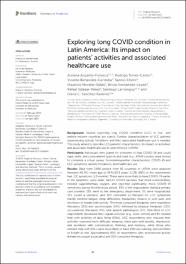Mostrar el registro sencillo del ítem
Exploring long COVID condition in Latin America: Its impact on patients’ activities and associated healthcare use
| dc.contributor.author | Angarita-Fonseca, Adriana | |
| dc.contributor.author | Torres-Castro, Rodrigo | |
| dc.contributor.author | Benavides-Cordoba, Vicente | |
| dc.contributor.author | Chero, Santos | |
| dc.contributor.author | Morales-Satán, Mauricio | |
| dc.contributor.author | Hernández-López, Bricia | |
| dc.contributor.author | Salazar-Pérez, Rafael | |
| dc.contributor.author | Larrateguy, Santiago | |
| dc.contributor.author | Sanchez-Ramirez, Diana C. | |
| dc.date.accessioned | 2023-10-16T19:33:12Z | |
| dc.date.available | 2023-10-16T19:33:12Z | |
| dc.date.issued | 2023-04-20 | |
| dc.identifier.uri | https://hdl.handle.net/20.500.13053/9550 | |
| dc.description.abstract | “Background: Studies exploring long COVID condition (LCC) in low- and middle-income countries are scarce. Further characterization of LCC patients experiencing activity limitations and their associated healthcare use is needed. This study aimed to describe LCC patients’ characteristics, its impact on activities, and associated healthcare use in Latin America (LATAM). Participants: Individuals who (cared for someone or) had COVID-19 and could read, write, and comprehend Spanish and lived in a LATAM country were invited to complete a virtual survey. Sociodemographic characteristics, COVID-19 and LCC symptoms, activity limitations, and healthcare use. Results: Data from 2,466 people from 16 countries in LATAM were analyzed (females = 65.9%; mean age of 39.5 ± 53.3 years). 1,178 (48%) of the respondents had LCC symptoms (≥3 months). These were more likely to have COVID-19 earlier in the pandemic, were older, had no COVID vaccines, had more comorbidities, needed supplementary oxygen, and reported significantly more COVID-19 symptoms during the infectious period. 33% of the respondents visited a primary care provider, 13% went to the emergency department, 5% were hospitalized, 21% visited a specialist, and 32% consulted ≥1 therapist for LCC symptoms mainly extreme fatigue, sleep difficulties, headaches, muscle or joint pain, and shortness of breath with activity. The most consulted therapists were respiratory therapists (15%) and psychologists (14%), followed by physical therapists (13%), occupational therapists (3%), and speech pathologists (1%). One-third of LCC respondents decreased their regular activities (e.g., work, school) and 8% needed help with activities of daily living (ADLs). LCC respondents who reduced their activities reported more difficulty sleeping, chest pain with activity, depression, and problems with concentration, thinking, and memory, while those who needed help with ADLs were more likely to have difficulty walking, and shortness of breath at rest. Approximately 60% of respondents who experienced activity limitations sought a specialist and 50% consulted therapists. Conclusions and relevance: Results supported previous findings in terms of the LCC demographics, and provided insight into LCC impact on patients’ activities and healthcare services used in LATAM. This information is valuable to inform service planning and resource allocation in alignment with the needs of this population.“ | es_PE |
| dc.format | application/pdf | es_PE |
| dc.language.iso | eng | es_PE |
| dc.publisher | Frontiers Media S.A. | es_PE |
| dc.rights | info:eu-repo/semantics/openAccess | es_PE |
| dc.rights.uri | https://creativecommons.org/licenses/by/4.0/ | es_PE |
| dc.subject | activity limitations, long COVID, healthcare use, long COVID disability, Latin America | es_PE |
| dc.title | Exploring long COVID condition in Latin America: Its impact on patients’ activities and associated healthcare use | es_PE |
| dc.type | info:eu-repo/semantics/article | es_PE |
| dc.identifier.doi | 10.3389/fmed.2023.1168628 | |
| dc.type.version | info:eu-repo/semantics/publishedVersion | es_PE |
| dc.publisher.country | CHE | es_PE |
| dc.subject.ocde | 3.03.00 -- Ciencias de la salud | es_PE |
Ficheros en el ítem
Este ítem aparece en la(s) siguiente(s) colección(es)
-
Web of Science (WOS) [236]


